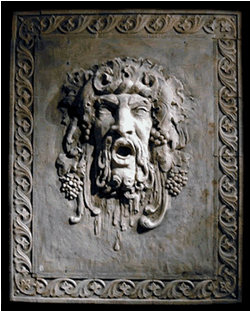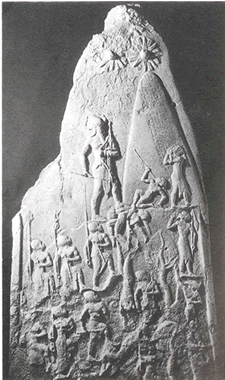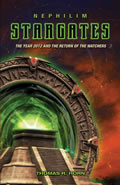READ
IT BEFORE IT'S BANNED BY THE US GOVERNMENT
PART 19
By Thomas R. Horn
August 18, 2009
NewsWithViews.com
DIONYSUS: THE PSYCHOTIC ASPECT OF THE DEMON APOLLO/OSIRIS
Around
the first century BC, historians began using the term ‘Osiris-Dionysus’
to commonly refer to dying-and-resurrecting deities, often part-human
and born of ‘virgins’ that were  worshipped
in the years before the emergence of Jesus Christ. In the 5th century
BC, Herodotus spoke in particular of the syncretic relationship between
Osiris and Dionysus, the thirteenth god of the Greeks. By adding Dionysus
to what we have already written about Osiris and Apollo, one can imagine
a kind of demonic trinity—a single spirit represented in three manifestations,
each of which illustrate a different side of the entity’s makeup.
While as Osiris, this spirit is the god of death and the underworld, and
as Apollo he is an oracular sun deity and destroyer demon, as Dionysus
he is superficially depicted as the inventor of wine, abandon, and revelry,
a description that seems inadequate in that it refers only to the basic
elements of intoxication and enthusiasm, which was used of the Bacchae
(the female participants of the Dionystic mysteries; also known as Maenads
and Bacchantes) in their rituals to experience Dionysus, the intoxicating
god of unbridled human desire.
worshipped
in the years before the emergence of Jesus Christ. In the 5th century
BC, Herodotus spoke in particular of the syncretic relationship between
Osiris and Dionysus, the thirteenth god of the Greeks. By adding Dionysus
to what we have already written about Osiris and Apollo, one can imagine
a kind of demonic trinity—a single spirit represented in three manifestations,
each of which illustrate a different side of the entity’s makeup.
While as Osiris, this spirit is the god of death and the underworld, and
as Apollo he is an oracular sun deity and destroyer demon, as Dionysus
he is superficially depicted as the inventor of wine, abandon, and revelry,
a description that seems inadequate in that it refers only to the basic
elements of intoxication and enthusiasm, which was used of the Bacchae
(the female participants of the Dionystic mysteries; also known as Maenads
and Bacchantes) in their rituals to experience Dionysus, the intoxicating
god of unbridled human desire.
Ancient followers of Dionysus believed he was the presence that is otherwise defined as the craving within man that longs to "let itself go" and to "give itself over" to baser earthly desires. What a Christian might resist as the lustful wants of the carnal man, the followers of Dionysus embraced as the incarnate power that would, in the next life, liberate the souls of mankind from the constraints of this present world and from the customs which sought to define respectability through a person’s obedience to moral law. Until that day arrive, the worshippers of Dionysus attempted to bring themselves into union with the god through a ritual casting off of the bonds of sexual denial and primal constraint by seeking to attain a higher state of ecstasy. The uninhibited rituals of ecstasy (Greek for "outside the body") was believed to bring the followers of Dionysus into a supernatural condition that enabled them to escape the temporary limitations of the body and mind and to achieve a state of enthousiasmos, or, outside the body and "inside the god." In this sense Dionysus represented a dichotomy within the Greek religion, as the primary maxim of the Greek culture was one of moderation, or, "nothing too extreme." But Dionysus embodied the absolute extreme in that he sought to inflame the forbidden passions of human desire. Interestingly, and most students of psychology will understand, this gave Dionysus a stronger allure among the Greeks who otherwise tried in so many ways to suppress and control the wild and secret lusts of the human heart. Dionysus resisted every such effort, and, according to myth, visited a terrible madness upon those who tried to deny him free expression.
This Dionystic idea of mental disease resulting from the suppression of secret inner desires, especially aberrant sexual desires, was later reflected in the atheistic teachings of Sigmund Freud. Freudianism might therefore be called the grandchild of the cult of Dionysus. Conversely, the person who gave himself over to the will of Dionysus was rewarded with unlimited psychological and physical delights. These mythical systems of mental punishments and physical rewards based on resistance and/or submission to Dionysus, were both symbolically and literally illustrated in the cult rituals of the Bacchae, as the Bacchae women (married and unmarried Greek women had the "right" to participate in the mysteries of Dionysus) migrated in frenzied hillside groups, dressed transvestite in fawn skins and accompanied by screaming, music, dancing, and licentious behavior. When, for instance, a baby animal was too young and lacking in instinct to sense the danger and run away from the revelers, it was picked up and suckled by nursing mothers who participated in the hillside rituals. On the other hand, when older animals sought to escape the marauding Bacchae, they were considered "resistant" to the will of Dionysus and were torn apart and eaten alive as a part of the fevered ritual. Human participants were sometimes subjected to the same orgiastic cruelty, as the rule of the cult was "anything goes," including lesbianism, beastiality, etc. Later versions of the ritual (Bacchanalia) expanded to include pedophilia and male revelers, and perversions of sexual behavior were often worse between men than they were between men and women. Any creature that dared to resist such perversion of Dionysus was subjected to sparagmos ("torn apart’) and omophagia ("consumed raw").
In B.C. 410, Euripides wrote of the bloody rituals of the Bacchae in his famous play, The Bacchantes:
the Bacchantes....with hands that bore no weapon of steel, attacked our cattle as they browsed. Then wouldst thou have seen Agave mastering some sleek lowing calf, while others rent the heifers limb from limb. Before thy eyes there would have been hurling of ribs and hoofs this way and that, and strips of flesh, all blood be-dabbled, dripped as they hung from the pine branches. Wild bulls, that glared but now with rage along their horns, found themselves tripped up, dragged down to earth by countless maidens hands. [1]
Euripedes went on to describe how Pentheus, the King of Thebes, was torn apart and eaten alive by his own mother as, according to the play, she fell under the spell of Dionysus.
Tearing apart and eating alive of a sacrificial victim may refer to the earliest history of the cult of Dionysus. An ancient and violent cult ritual existing since the dawn of paganism stipulated that, by eating alive, or by drinking the blood, of an enemy or an animal, a person might somehow capture the essence or "soul-strength" of the victim. The earliest Norwegian huntsmen believed in this idea, and drank the blood of bears in an effort to capture their physical strength. East African Masai warriors also practiced omophagia and sought to gain the strength of the wild by drinking the blood of lions. Human victims were treated in this way by Arabs before Mohammed, and head-hunters of the East Indies practiced omophagia in an effort to capture the essence of their enemies.
Today, omophagia is practiced by certain Voodoo sects as well as by cult Satanists, possibly illustrating an ongoing effort on the part of Satan to distort the Original Revelation of God, as eating human flesh and drinking human blood to "become one" with the devoured is a demonization of the Eucharist or Holy Communion. While the goal of the Satanist is to profane the Holy, sparagmos and omophagia, as practiced by the followers of Dionysus, was neither an attempt at sacrilege or of transubstantiation (as in the Catholic Eucharist), nor of consubstantiation (as in the Lutheran communion), nor yet of a symbolic ordinance (as in evangelical circles), all of which have as a common goal elevating the worshipper into sacramental communion with God. The goal of the Bacchae was the opposite—the frenzied dance; the thunderous song; the licentious behavior; the tearing apart and eating alive; all were efforts on the part of the Bacchae to capture the essence of the god (Dionysus) and to bring him down into incarnated rage within man. The idea was not one of Holy Communion, but of possession by the spirit of Dionysus. When one recalls the horrific rituals of the followers of Dionysus, it’s easy to believe demonic possession actually occurred. A Christian should find this idea plausible, and, it would seem, so did the Hebrews.
The Hebrew people considered Hades (the Greek god of the underworld) to be equal with Hell and/or the Devil, and many ancient writers likewise saw no difference between Hades (in this sense the Devil) and Dionysus. Euripedes echoed this sentiment in the Hecuba, and referred to the followers of Dionysus as the "Bacchants of Hades." In Syracuse, Dionysus was known as Dionysus Morychos ("the dark one") a fiendish creature; roughly equivalent to the biblical Satan, who wore goatskins and dwelt in the regions of the underworld. In the scholarly book, Dionysus Myth And Cult, Walter F. Otto connected Dionysus with the prince of the underworld. He wrote:
The similarity and relationship which Dionysus has with the prince of the underworld (and this is revealed by a large number of comparisons) is not only confirmed by an authority of the first rank, but he says the two deities are actually the same. Heraclitus says, "...Hades and Dionysus, for whom they go mad and rage, are one and the same." [2]
Some Hebrews considered the magic (witchcraft) of the Bacchae to be the best evidence of Dionysus’ Satanic connection, and, while most of the details are no longer available because Dionysus was a mystery god and his rituals were revealed to the initiated only, the Hebrew prophet Ezekiel made an important statement about the "magic bands" (kesatot) of the Bacchae, which, as in the omophagia, were used to capture (magically imprison) the souls of men. We read, "Wherefore thus saith the Lord God; Behold I am against your pillows [kesatot, "magic bands"] wherewith ye there hunt the souls to make them fly, and I will tear them from your arms and will let the souls go, even the souls that ye hunt to make them fly" (Ez. 13:20). The kesatot was a magic arm band used in connection with a container called the kiste. Wherever the kiste is inscribed on sarcophagi and on Bacchic scenes, it is depicted as a sacred vessel (a soul prison?) with a snake peering through an open lid. How the magic worked and in what way a soul was imprisoned is still a mystery. Pan, the half-man/half-goat god (later relegated to devildom) is sometimes pictured kicking the lid open and letting the snake (soul?) out. Such loose snakes were then depicted as being enslaved around the limbs, and bound in the hair, of the Bacchae women. Whatever this imagery of Pan, the serpents, the imprisoned souls, and the magic Kesatot and Kiste actually represented, a noteworthy verification of the magical properties represented by them is discussed in the scholarly book Scripture and Other Artifacts by Phillip King and Michael David:
In the closing verses of Ezekiel 13 the prophet turns his attention to magic practices whose details remain obscure. Two key terms are kesatot and mispabot…. The kesatot are "sewn" on the arms, while the mispabot are made "on the head of every height" (?), which has been understood to mean "on the heads of persons of every height" [including those of great height; giants, offspring of the Watchers]…
In modern times archaeological discoveries and texts from Babylonia in particular have shed further light on what might be involved: G. A. Cooke cited Hellenistic figurines from Tell Sandahannah (Mareshah) in Palestine with wire twisted around their arms and ankles… and a magical text from Babylonia that speaks of white and black wool being bound to a person or to someones bed…. J. Herrmann [notes] that both words can be related to Akkadian verbs, kasu and sapabu, which mean respectively "to bind" and "to loose"…. Herrmann also drew attention to texts in which these verbs were used in a specifically magical sense…. This indicates that, whatever the objects were, their function was to act as "binders" and "loosers" in a magical sense, in other words as means of attack and defense in sorcery. [3]
The
text in Ezekiel is believed to specifically refer to Dionysian or Bacchanalian
magic, which is important in the context of this blog series when combined
with a related two-part "binding" and "loosing" question
from God in Job 38:31: "Canst thou bind the sweet influences of Pleiades,
or loose the bands of Orion?" The first part of God’s challenge
to Job here involves the star cluster Pleides, which in mythology represented
the Seven  Sisters
or teachers of the infant Dionysus, the very priestesses of whom used
the kesatot and kiste to magically "bind"
those souls that Ezekiel said God would "loose." The second
part of God’s proposition to Job is equally meaningful, "Can
you… loose the bands of Orion?" Studies in recent years have
made intriguing findings that suggest the Giza Plateau—which according
to Zahi Hawass (current Secretary General of Egypt’s Supreme Council
of Antiquities), was known to ancient Egyptians as the "House of
Osiris, Lord of the Underground Tunnels"—was designed to reflect
the constellation Orion. The three pyramids of Giza do appear to be laid
out in a pattern reflecting the three stars of Orion, which is none other
than the heavenly representation of Osiris.
Sisters
or teachers of the infant Dionysus, the very priestesses of whom used
the kesatot and kiste to magically "bind"
those souls that Ezekiel said God would "loose." The second
part of God’s proposition to Job is equally meaningful, "Can
you… loose the bands of Orion?" Studies in recent years have
made intriguing findings that suggest the Giza Plateau—which according
to Zahi Hawass (current Secretary General of Egypt’s Supreme Council
of Antiquities), was known to ancient Egyptians as the "House of
Osiris, Lord of the Underground Tunnels"—was designed to reflect
the constellation Orion. The three pyramids of Giza do appear to be laid
out in a pattern reflecting the three stars of Orion, which is none other
than the heavenly representation of Osiris.
In Greek mythology, the god Orion (Osiris) fell in love with Apollo’s sister, Diana (Artemis). Apollo did not like this arrangement and tricked Diana into shooting an arrow into Orion’s head. When she saw what she had done, Diana placed the dead Osiris among the stars and transformed him into the constellation Orion. Thereafter, Orion was thought to be the "Soul of Osiris."
Earlier history connects the constellation Orion to the Sumerian legend of Gilgamesh, identified in the Bible as Nimrod—the giant "mighty hunter" before the Lord—a fantastic personality who in later mythology was also called Osiris and Apollo. If Job 38:31 is therefore interpreted according to these ancient astrological and mythological renderings, it would have God asking Job if he could bind the magic bands (kesatot?) of Osiris-Dionysus or loose the bindings (mispabot?) of the Mighty Hunter, the giant Orion/Gilgamesh/Nimrod/Osiris/Apollo. What is potentially more explosive is the deep possible implication from this text that not only can God do this—that is, loose the forces bound at Giza and the constellation Orion—but that, when the correct time comes, He will.
When the star systems Pleides and Orion are compared to Henry Wallace’s letter to Nicholas Roerich in which he said, "Dear Guru, I have been thinking of you holding the casket—the sacred most precious casket. And I have thought of the New Country going forward to meet the seven stars under the sign of the three stars," the mystery may unfold that Wallace was referring to the Pleides and Orion specifically and to the deity, and earthly location, they represent. This is an excellent possibility, as these star systems—the seven stars of the Pleides and the three stars of Orion—relate to one another in mythology as well as in the Bible. Further, both star systems represent the god encoded in the Great Seal, the central fascination of Wallace and Roosevelt. The Pleides points to Apollo-Dionysus while the Orion system points to the Soul of Osiris in heaven and, on earth, to his speculative tomb location in Giza. If Wallace was referring to these star systems by his cryptic phrase "going forward to meet the seven stars under the sign of the three stars," Roerich and Wallace may have believed the New Country (America as the New Atlantis) was destined to meet Apollo-Dionysus under the sign of the three stars (on the Giza Plateau), where the most precious casket or ‘coffin’ of Osiris-Apollo-Dionysus held the material remains of the god.
Belief that these gods—or more accurately the single entity represented by these many names—would return to rule the earth one day, is not limited to Masonic mystics or the divine manifestation from the Apostle Paul to the Thessalonians (2 Thessalonians 2:3). The return of these gods "to an active and outward position as rulers of mankind is predicted in the Asclepius," notes Peter Goodgame, "which is predicted to come after the long period of spiritual decline in Egypt."
The prophecy Goodgame refers to from the ancient Asclepius says: "Those gods who rule the earth will be restored, and they will be installed in a city at the furthest threshold of Egypt, which will be founded towards the setting sun and to which all human kind will hasten by land and by sea."
Goodgame notes the physical whereabouts of the "city" in this prophecy is the Giza Plateau, as located by Garth Fowden in his book, The Egyptian Hermes.
"… in answer to Asclepius enquiry where these gods are at the moment, Trismegistus replies (at Ascl. 27): ‘In a very great city, in the mountains of Libya (in monte Libyco)’, by which is meant the edge of the desert plateau to the west of the Nile valley. A subsequent reference (Ascl. 37) to the temple and tomb of Asclepius (Imhotep) in monte Libyae establishes that the allusion at Ascl. 27 is to the ancient and holy Memphite necropolis, which lay on the desert jabal to the west of Memphis itself."
"The ‘mountains of Libya,’" Goodgame concludes, "is simply a reference to the plateau that rises above the desert on the west bank of the Nile, west of the ancient city of Memphis. In other words, according to this Hermetic prediction, when the Kosmokrators are ‘restored’ they will be ‘installed in a city’ on or near the Giza Plateau." [4]
|
Subscribe to the NewsWithViews Daily News Alerts! |
Will the ancient super-man Apollo-Osiris rise from a hidden tomb at the Giza Plateau, as Goodgame believes may be the case? If so, the Asclepius could have been more than a pagan prophecy. It may have been a record pointing to where the body of the ‘god’ was stored in times past. Do the occult masters already know this, and is this why an unfinished pyramid adorns the Great Seal of the United States, over which the portentous eye of Apollo-Osiris glares from the ancient past? Has DNA been recovered from Giza that is needed for the return of this god? Will a forbidden ‘science’ that once allowed incarnation and ‘deity’ status to powerful fallen beings be restored in this modern age? Prophecy may suggest exactly this, and for the immediate future.
[See the U-Tube clip above: Apollyon Rising 2012: The Lost Symbol Found and the Final Mystery of the Great Seal Revealed]
Footnotes:
1.
Euripides, The Bacchantes, Dramatis Personare (Messenger to Pentheus concerning
the Bacchantes), BC 410
2.
Walter F. Otto, Dionysus Myth and Cult (Indianapolis, IN: Indiana University
Press, 1965), p 114
3.
Scripture and Other Artifacts: Essays on the Bible and Archaeology
in Honor of Philip J. King, By Philip J. King, Michael David Coogan,
J. Cheryl Exum, Lawrence E. Stager, Contributor Michael David Coogan,
J. Cheryl Exum, Lawrence E. Stager, pg 121, Westminster John Knox Press,
1994
4.
See, Domination
by Deception
[Editor's note: This series is based on research contained in Tom Horn's upcoming new book: APOLLYON RISING 2012: The Final Mystery Of The Great Seal Revealed. Sign up to be notified when APOLLYON RISING 2012 is released and get $60.00 IN FREE GIFTS! Sign up here!]
Click here for part -----> 1, 2, 3, 4, 5, 6, 7, 8, 9, 10, 11, 12, 13, 14, 15, 16, 17, 18,
Sign
Up For Free E-Mail Alerts
E-Mails are used strictly for
NWVs alerts, not for sale
Thomas Horn is the CEO of RaidersNewsNetwork.com and SurvivorMall.com.
Over the last decade, he has authored three books, wrote dozens of published editorials, and had several feature magazine articles. In addition to past articles at NewsWithViews.com , his works have been referred to by writers of the LA Times Syndicate, MSNBC, Christianity Today, Coast to Coast, World Net Daily, White House Correspondents and dozens of newsmagazines and press agencies around the globe. Tom's latest book is "The Ahriman Gate," which fictionalizes the use of biotechnology to resurrect Biblical Nephilim.
Thomas is also a well known radio personality who has guest-hosted and appeared on dozens of radio and television shows over the last 30 years, including "The 700 Club" and "Coast to Coast AM." When looking for a spokesperson to promote their film "Deceived" staring Louis Gossett Jr. and Judd Nelson, "Cloud 10 Pictures" selected Thomas as their spokesperson to explain the Christian viewpoint on UFO-related demonology.
Web Site: RaidersNewsNetwork.com
E-Mail: RaidersNewsUpdate@gmail.com














